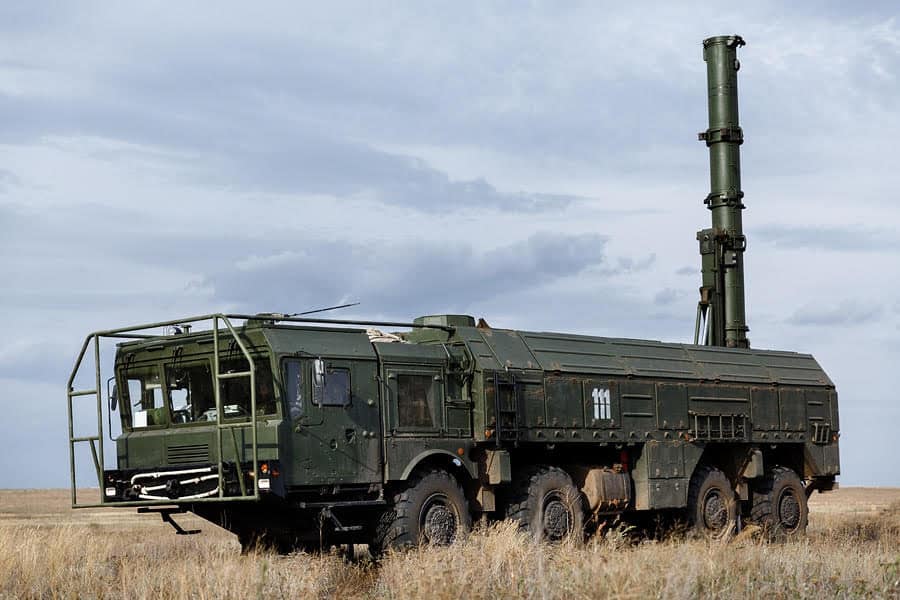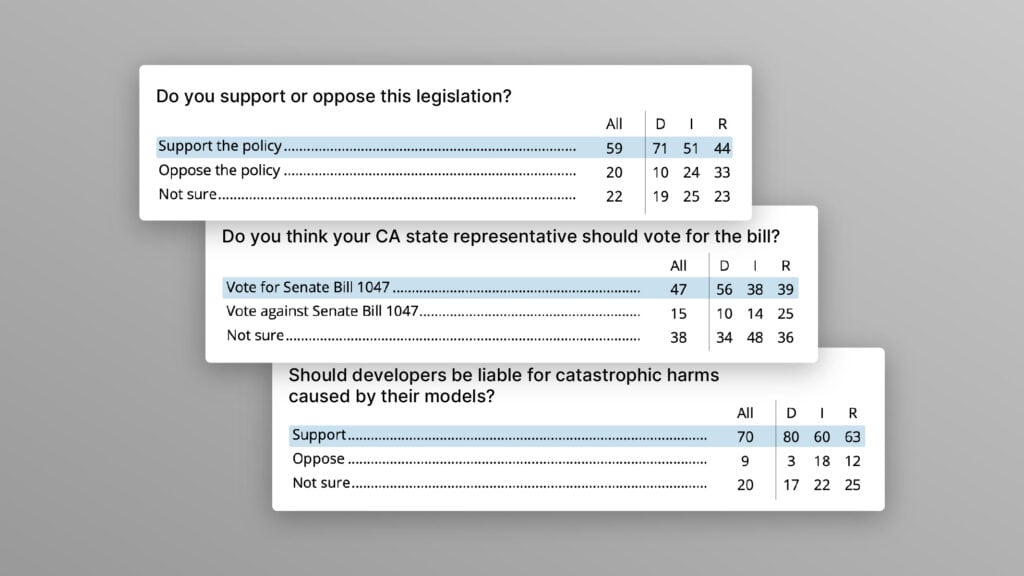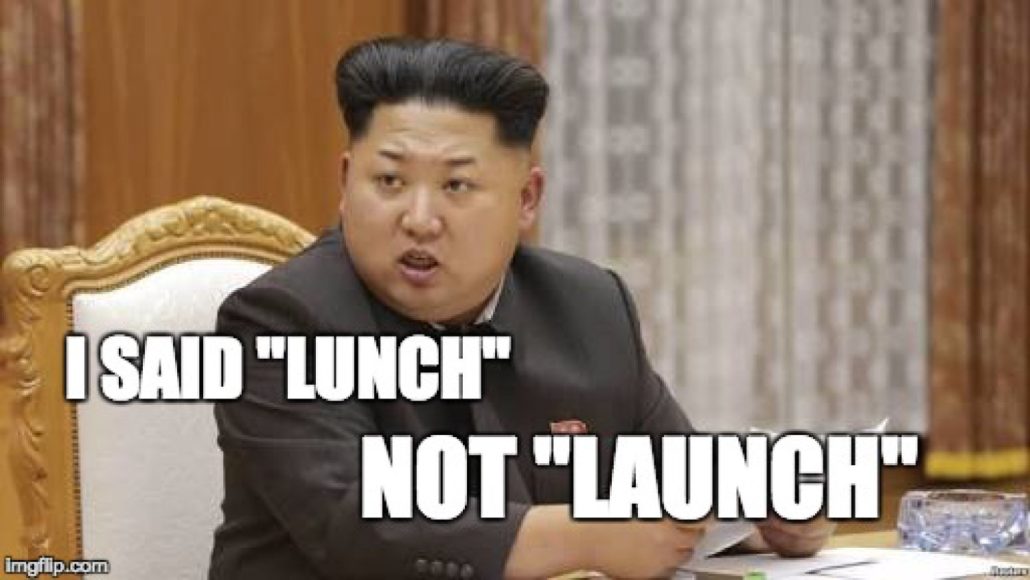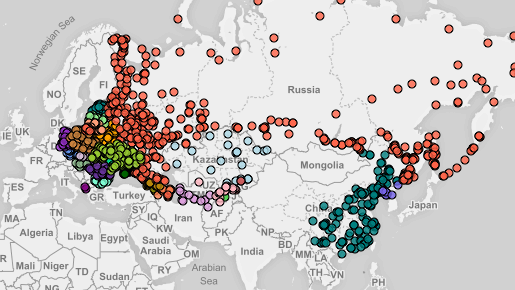The Breakdown of the INF: Who’s to Blame for the Collapse of the Landmark Nuclear Treaty?

Contents
On February 1, a little more than 30 years after it went into effect, the United States announced that it is suspending the Intermediate-Range Nuclear Forces (INF) Treaty. Less than 24 hours later, Russia announced that it was also suspending the treaty.
It stands (or stood) as one of the last major nuclear arms control treaties between the U.S. and Russia, and its collapse signals the most serious nuclear arms crisis since the 1980s. As Malcolm Chalmers, deputy director general of the Royal United Services Institute, said to The Guardian, “If the INF treaty collapses, and with the New Start treaty on strategic arms due to expire in 2021, the world could be left without any limits on the nuclear arsenals of nuclear states for the first time since 1972.”
The INF treaty, which went into effect in 1988, was the first nuclear agreement to outlaw an entire class of weapons. It banned all ground-launched ballistic and cruise missiles — nuclear, conventional, and “exotic”— with a range of 500 km to 5500 km (310 to 3400 miles), leading to the immediate elimination of 2,692 short- and medium-range weapons. But more than that, the treaty served as a turning point that helped thaw the icy stalemate between the U.S. and Russia. Ultimately, the trust that it fostered established a framework for future treaties and, in this way, played a critical part in ending the Cold War.
Now, all of that may be undone.
The Blame Game Part 1: Russia vs. U.S.
In defense of the suspension, President Donald Trump said that the Russian government has deployed new missiles that violate the terms of the INF treaty — missiles that could deliver nuclear warheads to European targets, including U.S. military bases. President Trump also said that, despite repeated warnings, President Vladimir Putin has refused to destroy these warheads. “We’re not going to let them violate a nuclear agreement and do weapons and we’re not allowed to,” he said.
In a statement announcing the suspension of the treaty, Secretary of State Mike Pompeo said that countries must be held accountable when they violate a treaty. “Russia has jeopardized the United States’ security interests,” he said, “and we can no longer be restricted by the treaty while Russia shamelessly violates it.” Pompeo continued by noting that Russia’s posturing is a clear signal that the nation is returning to its old Cold War mentality, and that the U.S. must make similar preparations in light of these developments. “As we remain hopeful of a fundamental shift in Russia’s posture, the United States will continue to do what is best for our people and those of our allies,” he concluded.
The controversy about whether Russia is in violation hinges on whether the 9M729 missile can fly more than 500km. The U.S. claims to have provided evidence of this to Russia, but has not made this evidence public, and further claims that violations have continued since at least 2014. Although none of the U.S.-based policy experts interviewed for this article dispute that Russia is in violation, many caution that this suspension will create a far more unstable environment and that the U.S. shares much of the blame for not doing more to preserve the treaty.
In an emailed statement to the Future of Life Institute, Martin Hellman, an Adjunct Senior Fellow for Nuclear Risk Analysis at the Federation of American Scientists and Professor Emeritus of Electrical Engineering at Stanford University, was clear in his censure of the Trump administration’s decision and reasoning, noting that it follows a well-established pattern of duplicity and double-dealing:
The INF Treaty was a crucial step in ending the arms race. Our withdrawing from it in such a precipitous manner is a grave mistake. In a sense, treaties are the beginning of negotiations, not the end. When differences in perspective arise, including on what constitutes a violation, the first step is to meet and negotiate. Only if that process fails, should withdrawal be contemplated. In the same way, any faults in a treaty should first be approached via corrective negotiations.
Withdrawing in this precipitous manner from the INF treaty will add to concerns that our adversaries already have about our trustworthiness on future agreements, such as North Korea’s potential nuclear disarmament. Earlier actions of ours which laid that foundation of mistrust include George W. Bush killing the 1994 Agreed Framework with North Korea “for domestic political reasons,” Obama attacking Libya after Bush had promised that giving up its WMD programs “can regain a secure and respected place among the nations,” and Trump tearing up the Iran agreement even though Iran was in compliance and had taken steps that considerably set back its nuclear program.
In an article published by CNN, Eliot Engel, chairman of the House Committee on Foreign Affairs, and Adam Smith, chairman of the House Committee on Armed Services, echo these sentiments and add that the U.S. government greatly contributed to the erosion of the treaty, clarifying that the suspension could have been avoided if President Trump had collaborated with NATO allies to pressure Russia into ensuring compliance. “ allies told our offices directly that the Trump administration blocked NATO discussion regarding the INF treaty and provided only the sparest information throughout the process….This is the latest step in the Trump administration’s pattern of abandoning the diplomatic tools that have prevented nuclear war for 70 years. It also follows the administration’s unilateral decision to withdraw from the Paris climate agreement,” they said.
Russia has also complained about the alleged lack of U.S. diplomacy. In January 2019, Russian diplomats proposed a path to resolution, stating that they would display their missile system and demonstrate that it didn’t violate the INF treaty if the U.S. did the same with their MK-41 launchers in Romania. The Russians felt that this was a fair compromise, as they have long argued that the Aegis missile defense system, which the U.S. deployed in Romania and Poland, violates the INF treaty. The U.S. rejected Russia’s offer, stating that a Russian controlled inspection would not permit the kind of unfettered access that U.S. representatives would need to verify their conclusions. And ultimately, they insisted that the only path forward was for Russia to destroy the missiles, launchers, and supporting infrastructure.
In response, Russian foreign minister Sergei Lavrov accused the U.S. of being obstinate. “U.S. representatives arrived with a prepared position that was based on an ultimatum and centered on a demand for us to destroy this rocket, its launchers and all related equipment under US supervision,” he said.
Suggested Reading
Accidental Nuclear War: A Timeline of Close Calls
The most devastating military threat arguably comes from a nuclear war started not intentionally but by accident or miscalculation. Accidental nuclear war has almost happened many times already, and with 15,000 nuclear weapons worldwide — thousands on hair-trigger alert and ready to launch at a moment’s notice — an accident is bound to occur eventually.
The Blame Game Part 2: China
Other experts, such as Mark Fitzpatrick, Director of the non-proliferation program at the International Institute for Strategic Studies, assert that the “real reason” for the U.S. pullout lies elsewhere — in China.
This belief is bolstered by previous statements made by President Trump. Most notably, during a rally in the Fall of 2018, the President told reporters that it is unfair that China faces no limits when it comes to developing and deploying intermediate-range nuclear missiles. “Unless Russia comes to us and China comes to us and they all come to us and say, ‘let’s really get smart and let’s none of us develop those weapons, but if Russia’s doing it and if China’s doing it, and we’re adhering to the agreement, that’s unacceptable,” he said.
According to a 2019 report published for congress, China has some 2,000 ballistic and cruise missiles in its inventory, and 95% of these would violate the INF treaty if Beijing were a signatory. It should be noted that both Russia and the U.S. are estimated to have over 6,000 nuclear warheads, while China has approximately 280. Nevertheless, the report states, “The sheer number of Chinese missiles and the speed with which they could be fired constitutes a critical Chinese military advantage that would prove difficult for a regional ally or partner to manage absent intervention by the United States,” adding, “The Chinese government has also officially stated its opposition to Beijing joining the INF Treaty.” Consequently, President Trump stated that the U.S. has no choice but to suspend the treaty.
Along these lines, John Bolton, who became the National Security Adviser in April, has long argued that the kinds of missiles banned by the INF treaty would be an invaluable resource when it comes to defending Western nations against what he argues is an increasing military threat from China’s.
Pranay Vaddi, a fellow in the Nuclear Policy Program at the Carnegie Endowment for International Peace, feels differently. Although he does not deny that China poses a serious military challenge to the U.S., Vaddi asserts that withdrawing from the INF treaty is not a viable solution, and he says that proponents of the suspension “ignore the very real political challenges associated with deploying U.S. GBIRs in the Asia Pacific region. They also ignore specific military challenges, including the potential for a missile race and long-term regional and strategic instability.” He concludes, “Before withdrawing from the INF Treaty, the United States should consult with its Asian allies on the threat posed by China, the defenses required, and the consequences of introducing U.S. offensive missiles into the region, including potentially on allied territory.”
Suggested Reading
1100 Declassified U.S. Nuclear Targets
The National Security Archives recently published a declassified list of U.S. nuclear targets from 1956, which spanned 1,100 locations across Eastern Europe, Russia, China, and North Korea. This map shows all 1,100 nuclear targets from that list, demonstrating how catastrophic a nuclear exchange between the United States and Russia could be.
Six Months and Counting
Regardless of how much blame each respective nation shares, the present course has been set, and if things don’t change soon, we may find ourselves in a very different world a few months from now.
According to the terms of the treaty, if one of the parties breaches the agreement then the other party has the option to terminate or suspend it. It was on this basis that, back in October of 2018, President Trump stated he would be terminating the INF treaty altogether. Today’s suspension announcement is an update to these plans.
Notably, a suspension doesn’t follow the same course as a withdrawal. A suspension means that the treaty continues to exist for a set period. As a result, starting Feb. 1, the U.S. began a six-month notice period. If the two nations don’t reach an agreement and decide to restore the treaty within this window, on August 2nd, the Treaty will go out of effect. At that juncture, both the U.S. and Russia will be free to develop and deploy the previously banned nuclear missiles with no oversight or transparency.
The situation is dire, and experts assert that we must immediately reopen negotiations. On Friday, before the official U.S. announcement, German Chancellor Angela Merkel said that if the United States announced it would suspend compliance with the treaty, Germany would use the six-month formal withdrawal period to hold further discussions. “If it does come to a cancellation today, we will do everything possible to use the six-month window to hold further talks,” she said.
Following the US announcement, German Foreign Minister Heiko Maas tweeted, “there will be less security without the treaty.” Likewise, Laura Rockwood, executive director at the Vienna Center for Disarmament and Non-Proliferation, noted that the suspension is a troubling move that will increase — not decrease — tension and conflict. “It would be best to keep the INF in place. You don’t throw the baby out with the bathwater. It’s been an extraordinarily successful arms control treaty,” she said.
Carl Bildt, a co-chair of the European Council on Foreign Relations, agreed with these sentiments, noting in a tweet that the INF treaty’s demise puts many lives in peril. “Russia can now also deploy its Kaliber cruise missiles with ranges around 1.500 km from ground launchers. This would quickly cover all of Europe with an additional threat,” he said.
And it looks like many of these fears are already being realized. In a televised meeting over the weekend, President Putin stated that Russia will actively begin building weapons that were previously banned under the treaty. President Putin also made it clear that none of his departments would initiate talks with the U.S. on any matters related to nuclear arms control. “I suggest that we wait until our partners are ready to engage in equal and meaningful dialogue,” he said.
The photo for this article is from wiki commons: by Mil.ru, CC BY 4.0, https://commons.wikimedia.org/
About the Future of Life Institute
The Future of Life Institute (FLI) is a global think tank with a team of 20+ full-time staff operating across the US and Europe. FLI has been working to steer the development of transformative technologies towards benefitting life and away from extreme large-scale risks since its founding in 2014. Find out more about our mission or explore our work.
Related content
Other posts about Nuclear, Recent News

The U.S. Public Wants Regulation (or Prohibition) of Expert‑Level and Superhuman AI

Poll Shows Broad Popularity of CA SB1047 to Regulate AI




